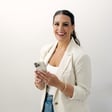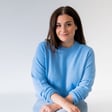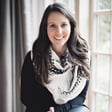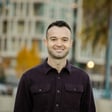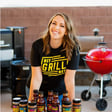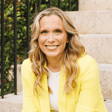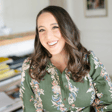Become a Creator today!Start creating today - Share your story with the world!
Start for free
00:00:00
00:00:01

Episode 182 - Create a Stellar Ad Campaign on any Platform
In today's episode I'm sharing what I think are the principals for creating a stellar ad campaign on any platform. This is from the outline of a presentation that I gave at Spark Conference (Showit's conference) in November 2022.
Episode Sponsor: If you are struggling with projects, sign up for Basecamp. Their pricing is simple and they give you ALL their features in a single plan. No upsells. No upgrades.
Go to basecamp.com/daveyandkrista and try Basecamp for free. No credit card required and cancel anytime.
As always, links and resources can be found in the show notes. Check 'em out at https://daveyandkrista.com/ And if you enjoyed this episode, please consider leaving a review over at Apple Podcasts.
Transcript
Video vs. Static Images in Ads
00:00:05
Speaker
One thing that really helps, it seems like, and will continue, is video. You know, any sort of movement in an ad, I think that catches people's attention. But when everybody's using video, there'll probably be more nuances to that. There are definitely campaigns that we run, too, where a static image is doing better. So it's not that a static image can't catch somebody's attention.
Introduction to Brands at Book Show
00:00:28
Speaker
Welcome to the Brands at Book Show, where we help creative, service-based businesses build their brands and find more clients. I'm your host, Davy Jones.
00:00:37
Speaker
Want to know how to create an effective ad on any digital platform? Today we're focusing on the underlying principles that make a successful digital advertisement.
Role of Messaging and Copy in Advertising
00:00:46
Speaker
Bit of a spoiler, messaging or copy make a huge difference, and it's really the copy that drives the creative process. We talk about the importance of client avatars, speaking to a specific audience, and how that can lower your costs, and tips for writing copy if you don't feel like you're a good writer.
00:01:03
Speaker
As always, links and resources can be found in the show notes. Check them out at davianchrista.com. And if you enjoyed this episode, please consider leaving a review over an Apple podcast.
Sponsors and Personal Anecdotes
00:01:15
Speaker
Alright, a big thanks to Basecamp, the project management platform, for sponsoring this episode. Imagine working with your team on a project and you're trying to do everything over email. Things seem to work well enough at the beginning, but once you start adding more than a couple people or sharing more than a couple files, the entire project becomes disorganized.
00:01:35
Speaker
Managing projects is tough enough. It's a struggle to juggle people, work, and expectations under pressure. Problem is, many project management platforms make it even harder by overcomplicating things, leading teams to abandon tools when the promise fades and frustration sets in.
00:01:52
Speaker
That's when teams turn to Basecamp. Famously straightforward and effective, teams stick with it and projects thrive on it. Basecamp makes collaborating on projects easy without having to waste time. Teams that use Basecamp send less emails and have fewer meetings. If you are struggling with projects, sign up for Basecamp. Their pricing is simple and they give you all their features in a single plan, no upsells, no upgrades.
00:02:17
Speaker
Go to basecamp.com forward slash Davie and Krista and try Basecamp for free. No credit card required and cancel anytime.
00:02:31
Speaker
You have cold over there. I am cold. You turned off our heater. Well, I'm cleaning the filter. Filter has to dry, all right, before I put it back in. And I like it. It's invigorating. Normally, you complain about the cold. Yeah, but I mean, this is like, this is not real cold. You know, it's not like we're sitting outside recording this episode and today is chilly.
00:02:49
Speaker
Will you complain when I have the house at 65 degrees? Okay, this is true. I typically, during the daytime, don't want it to feel like I'm in an icebox. Yeah, I feel like I'm in an icebox right now. It's chilly. The office is over the garage. I don't know if this happened around the whole country, but I feel like we got this early winter spell, at least where we live. Oh yeah, I think it's pretty widespread in the Northeast. Like all the snow in Buffalo, which is crazy, right? There's Buffalo six feet of snow.
00:03:15
Speaker
Something crazy like that. Yeah, for sure. They just moved the Buffalo Bills game. So people are listening to this. They're like, that was weeks ago. This episode, actually this episode, I think might not go live until the new year, which is crazy. Yeah. We are so far ahead. I know. You're welcome. You're welcome. And happy new year to everybody
Insights from Spark Conference
00:03:34
Speaker
listening.
00:03:34
Speaker
So in this episode, what we're doing is we are going through a presentation that I gave at Spark conference, which is show its new conference they held last year. They're unfortunately not holding this conference in 2023, but they are hosting it in 2024. So you should definitely check it out. I think show it holds one of the best conferences.
00:03:52
Speaker
Oh yeah, so much fun and so much great content. Yeah, and we've been to a lot of conferences. We have, yeah. And we've been to a lot of show at conferences too. That's right. I am excited to get back on the conference circuit in 2023. If you're going to a conference, let me know because I'm always trying to figure out more to go through. I feel like I got into a cycle of going to kind of the same ones each year, which is fine. Most of them I really enjoy. But anyways, looking for new conferences to attend. So if you know of any, let me know.
00:04:21
Speaker
But today, we are going through one of the presentations that I gave at Show It. And it was how to create a stellar paid advertising campaign on any platform. Yes. And we are going through part of it because you spoke for 90 minutes on it. Easy. And you know, it's one of those things too. It's funny. It's like, I was thinking like, oh, 90 minutes is a pretty long time.
Starting Ad Campaigns: Platforms and Budgets
00:04:40
Speaker
I thought we'd have way more time to actually workshop.
00:04:43
Speaker
ideas, right? There were a lot of questions, which was good. And it's just funny, you know, if you're sitting there and you're thinking, Oh, I could never create a course, like you're underestimating probably how much you know, you know what I'm saying? Like, it's always shocking to me, like, this, this outline is only about a page long, you know, but I think like each section of the outline could be its own podcast episode. I think it's four pages long, but okay.
00:05:10
Speaker
All right, well, we're definitely not going through all four pages. It is actually, it's longer than a page. Anyways, moving on, we're talking about how to create a seller ad campaign on any ad platform, which is a big promise. But I think that having now managed, I don't even know. A few million, million? Yeah, we're in the millions for sure. Dollars of advertising on digital platforms. At Till Agency? Yeah, there are quite a few things that we've learned along the way.
00:05:37
Speaker
And this doesn't apply to Facebook, Instagram. And when we're talking about any campaign, actually, we haven't run anything on Twitter, which is interesting. Pinterest, LinkedIn, TikTok. All of those, yep. So, TikTok, LinkedIn, Facebook, Instagram, Google, Pinterest. Pinterest. I would say that most of our clients, most of the money that we spent is going to be on Metis platforms, which are Facebook and Instagram and Google.
00:06:04
Speaker
But regardless of the platform, we found that there are certain principles that just work. So I want to focus on that a
Testing and Learning in Advertising
00:06:10
Speaker
little bit today. Hopefully, if you're thinking about running ads or you are currently running ads, some of this helps you maybe to go back and refine or if you've never run ads before to get started. And I think
00:06:21
Speaker
One thing that I emphasized during this presentation was that the way I learned how to do this was by just going and doing it. And I think that people, they're so scared to make a mistake, but mistakes are going to be made along the way. So you just have to dive in there and give it a shot. I always tell people if they're looking for a platform to start with, I think Facebook and Instagram is a great platform to start with. One, it's probably still the most advanced ad platform out there. Google's probably tied.
00:06:48
Speaker
But it's one of those where you can spend just a few dollars a day and kind of get your feet under you, kind of get an understanding of how the ad platform works without going in and spending a ton of money at once. Which is how we started. Yeah, we started by taking it slowly. We did just throw thousands of dollars. That's right. You want to make sure that if you are playing around with this for the first time, you want to set a low budget, you don't want to make expensive mistakes. So something I want to mention just kind of at the outset.
00:07:16
Speaker
I think we got a lot of really good questions too that I kind of want to just go through here at the beginning. What kinds of projects are worth advertising? So we had a lot of photographers wondering like, you know, should I advertise for just like my general services or is it more of like a product for courses and products and things like that?
00:07:33
Speaker
I'll say at the outset, I think this can work for pretty much any kind of business or advertising. It's going to vary across platform. Certain platforms are going to be better for certain kinds of advertisers. I was talking with a hotel in town the other day, and they were asking what kind of platforms would be best for them. And I was saying Google is the first one that comes to mind for them.
00:07:52
Speaker
Right.
Defining Client Avatar for Targeted Ads
00:07:53
Speaker
But if you're a photographer, Google could work for you. Same thing with Facebook or Instagram, especially if you're looking to do things like sell mini courses. If you have a budget for brand awareness and you just want to get some of your work out there, Facebook and Instagram are good platforms for that. Would you say that it works for weddings and wedding services or should you be prepared to spend a lot more for lead because the customer would have to spend so much more to book your service?
00:08:18
Speaker
Yeah, that's a good question. I would say that my mind goes to ads for any high volume business. And so mini sessions would be a service, but it's kind of done at volume, right? Where you might be able to shoot 50 mini sessions in a day. I don't do mini sessions, so I'm not sure. But you want to fill up your entire schedule. It doesn't take much to fill up that entire schedule.
00:08:42
Speaker
So on the grand scheme of things, it's still relatively low volume, but because the price point is generally more, it's generally inexpensive when compared to a wedding collection, you know, I think like ads could work.
00:08:56
Speaker
On the other hand though, if you are trying to sell a $5,000 plus wedding collection, do ads really help with that? I think they can. For our wedding photography business back in the day... We never ran ads. Yeah, and again, thinking about where your money's best spent. For us, we were only going to shoot 20 weddings a year. And so we could do that without running ads. We really focused on things like search engine optimization, sharing our work organically.
00:09:24
Speaker
Client gifting. Client gifting and vendor gifting as well. We tried to serve the vendors that we were working with really well. Especially wedding planners. Especially wedding planners. And then we tried to build relationships with wedding planners and venues as well. So I think that's important to go over because at the outset too, I don't want to make it seem like, oh, if I'm not spending money on digital ads, I'm doing something wrong. That is not the case. Yeah.
00:09:49
Speaker
Good. Yeah, I mean, that's how I think generally the concerns of the group, you know, people not feeling like they know what they were doing, targeting the right audience. And we're going to talk a little bit about that. And one of the most important things you can do to get in front of the right audience, we'll talk about that in a second. And then just skeptical if digital ads are even worth it on small scales.
00:10:10
Speaker
So hopefully we'll answer some of these questions even more thoroughly as we go on. So starting at the beginning, and Krista, you're going to have to keep me on track here because I feel like I could... This could be a two hour episode if we're not careful. Yeah, exactly. And if you're listening and you're like, oh, I wish it was a two hour episode, send me a note. We can make long form episodes work.
Importance of Strong Ad Copy
00:10:31
Speaker
We just have a feeling that people don't want a two hour episode. Yeah. Anyways, first things first.
00:10:36
Speaker
And we're talking about this a lot in the new year, creating a customer avatar, knowing your client or customer. I'm talking about sitting down, pen in hand, putting it to paper, and writing out who your ideal customer is. You might have more than one client avatar. We know people who with photography businesses, for instance, they have a luxury level
00:10:56
Speaker
where those people, those clients work with them, and then they have associate brands as well. And they're trying to target a different market than they are, than their luxury level brand.
00:11:07
Speaker
It's helpful to think about these as actual people. Give them a name. Think about how do they spend their time? What do they value? Where do they shop? What are their hopes and dreams? How do they decide? How do they make decisions in their life? That might seem like a lot, but it's not. I'd say you're only scratching the surface there. Talk about how your customer or client prioritizes their time.
00:11:30
Speaker
in their free time, what are they doing? What are they doing for work? How much does your customer or client care about their reputation? Where do they go for news? Where are they showing up? All of those things are things that are worth looking at. And the reason being is if you are, especially when it comes to running ads, if you write generic copy, and by copy, I mean the text that's associated with your ad, if you write generic copy,
00:11:56
Speaker
Typically, your costs are going to be higher because it's not catching the attention. It doesn't feel like it's speaking to anybody in particular. So it doesn't matter what buttons you're pushing in the background. If you're writing generic copy and you're not really speaking to anybody, you can expect maybe higher costs.
00:12:13
Speaker
And I mean, this amazing copy that speaks to your ideal client is also going to be helpful for brands and websites. I'll just throw that in there. Yeah. And I mean, not only for brands and websites, but you think about organic posts as well. And I think that's why one of the things that we tell people before running ads is look at the results they're getting organically. If you feel like you're getting good engagement organically, then it's a good indication that paid advertising might work.
00:12:38
Speaker
But that activity, you can take that copy and the things that you write about your ideal client or customer and your customer avatar, and you can pull it over to the copy that actually goes in your ads. One of the most powerful things you can do. Another thing that you can do that I think is really helpful
00:12:58
Speaker
in really focusing on benefits of working with you and not features is to create a transformation sheet. And this is super simple activity. I will post actually some of these resources that might be helpful for people. Two columns in the left hand column, what is the current reality of your prospective client or customer? What I mean is they're like, what are the current challenges or issues or hesitations or objections? How are they currently feeling now? All right, what's the issue? Then on the right hand side, if they were to work with you,
00:13:28
Speaker
What's the transformation? What are they then feeling? What's the reality after working with you? All of those things, great. I think there's probably going to be great pieces of copy that come out that can be used in ads.
00:13:44
Speaker
So one of the most important reasons to do that is
Synergy Between Copy and Creative Elements
00:13:48
Speaker
because you want to focus on benefits and not features. All right. And you really want to get clear on, and I think that this is key. We've talked about this a lot. What makes your product or service the very best product or service for your customer? All right. There are lots of different things. I'm trying to think of an example right now. I'm just looking at my podcasting gear, for instance. So I have this Roadcaster.
00:14:14
Speaker
When I first was getting started, this Roadcaster mixer, probably too advanced for what I needed. Do you know what I'm saying? So I had something that was more basic than this. That company who put together that more basic gear, right, was hopefully speaking directly to me about this.
00:14:31
Speaker
people just getting started with podcasting. They don't want to mess with the technical setup. You have 100 chords on your desk right now. They probably don't want to deal with that. Just to make the point here, this Roadcaster could have worked for me back then. It could have done what I needed to do to record a podcast, but it wasn't the very best product for me at the time.
00:14:54
Speaker
You want to make that point to your customer or client. We talk about, can that really work for someone like me? And being able to answer that question effectively. All right, moving on. One of the reasons that we're focusing on these kinds of activities so much, these transformations, these customer avatar activities, not only to talk about benefits, not only to answer that question well, but because every campaign begins with copy.
00:15:23
Speaker
This is true of any ad campaign that we start in Till Agency, even if it's purely video, right? Because I mean, you think about even if you were filming a movie, what would come before filming the movie? A script. A script, you know, right? It's always going to start with copy. So if you're a designer out there, don't be offended, all right? Krista will tell you.
00:15:45
Speaker
Oh my gosh, I get so frustrated when I don't have copy. Right? I think creative is driven by copy. It's so important to do. Now that doesn't mean that a designer can't, I don't know, kind of be in on that brainstorming, right? I think it does make even the copy better when the designer is thinking through that campaign as well. But everything starts with a copy.
00:16:06
Speaker
Typically, I like to go about writing a campaign this way. I'll start with headlines. I actually just recorded an episode with Ashlyn Carter, and in it, she mentions, you do not start with headlines. It's funny, but I think she would approve of this method.
00:16:24
Speaker
I feel like she was talking about blog posts and that kind of content, maybe not for ads. Yeah. What I'm saying here doesn't necessarily conflict. I start with headlines because headlines is going to help me come up with a few different angles. I'm going to use my different headlines to come up with a few different angles for the copy that I'm about to write. Then I jump in there and I actually write that copy.
00:16:47
Speaker
If you're wondering to yourself right now, hey, do I write short form copy? Should I write long form copy? We've tested both mixed results. So I don't think there's no definitive answer that, oh, short form copy is better performing than long form copy or vice versa.
00:17:02
Speaker
I think it ultimately depends on the campaign. This is something I used to tell my students, but I now tell the team over at Tell Agency, I guess over at DK as well, that you only need to write as much as you need to write. You know what I'm saying? Basically, every sentence should have a purpose, and if that means that you have to write something longer, then you have to write something longer.
00:17:20
Speaker
And if it means that it only requires few words, then it requires few words. And that's okay. So I wouldn't focus too much on that. I would say if you feel like you're not a good writer, keep things short and punchy. Short and punchy is usually going to be effective. So if you're not a good writer, you don't want to write this long ad copy, then no worries. Write something short and punchy.
00:17:43
Speaker
But anyways, I start with headline, then I move into writing that text, and then I come back to my headlines. Typically, after writing all that text out, I'm going to discover headlines in that. So I'm going to come back and I'll have found in that text copy, I'll start pulling out headlines, and I'll have even better headlines than when I started. So I always go back.
00:18:06
Speaker
When it comes to writing headlines, this is something that Ashley mentioned in her episode. If you haven't caught that episode, it's one of the more recent ones that was released. It was released in early December. Yep, that's right. And I think it's one of those things where I would try writing down at least 20 headlines for an ad campaign and then pick out the five best. Because in a given ad set, if you're testing things dynamically, you can only test five at a time anyways.
00:18:32
Speaker
So try to narrow it down to your five best headlines. Any questions about that?
00:18:39
Speaker
I don't think so. Yeah. All right. So I'm going to keep on going. There's more I could say here. I know. I'm looking at your outline. There's a lot more. Yeah. But especially if you're listening to the different episodes that we're releasing, you know, some of the gaps
Visuals and Creative Boundaries in Advertising
00:18:50
Speaker
are filled in. I think by those episodes, I just recorded an episode with Candace Copla. And so I will share when her episode releases, but we get into some copywriting stuff there as well. This is your on her podcast. That's right. Yeah, that's right. Yeah.
00:19:03
Speaker
So moving on to creative, like I said, I think creative is driven by copy. Okay. Now, but you want to, you want to keep in mind, like when you're looking at an ad, I'm thinking on Facebook and Instagram, what is the first thing to catch your eye? The actual like visual of the ad.
00:19:18
Speaker
Yeah, typically it's the ad visual, right? And so it is important that you catch people's attention with the creative. Okay, that's typically what catches people's eyes. Then their eyes typically move to the headline and then to the text above or below. Descriptive, yeah. Depending on what kind of ad it is, right? So creative is important. What catches people's attention? Something that's out of the ordinary or out of place, right? Or of course, something that someone is already looking for, okay? But I would, using something that's out of place or out of the
00:19:48
Speaker
ordinary. One thing that really helps it seems like and will continue is video. Any sort of movement in an ad, I think that catches people's attention. But when everybody's using video, there'll probably be more nuances to that.
00:20:03
Speaker
There are definitely campaigns that we run to where a static image is doing better. So it's not that a static image can't catch somebody's attention. I think one of the things that we've had conversations about at DK is we have a very established aesthetic. And so I've really been pushing our creative team. Me? You can't see it, but he's giving me a face.
00:20:28
Speaker
to do something that's a little bit different. Because again, it's one of those things where it's like the same things over and over and over again are not going to catch people's attention. So something that we've been talking about as well. I will actually include the different dimensions that creative needs to be for the different ad platforms, either in the show notes or we do have a download that covers some of this stuff. So I'll link to that download as well.
00:20:54
Speaker
Thankfully, a lot of them are similar sizes, if not the same sizes. So if you create one for meta, it can often be used for Pinterest idea pins size too.
00:21:05
Speaker
You know what I'll do is in the show notes, if there are any rules like that that I'm leaving out here, I will include those in the show notes. It's probably still a good rule of thumb though. Your ad should not just be all text. Oh, for sure. In general, when it comes to writing text, when I was talking about short and punchy, even long form text should be punchy. And what I mean is like,
00:21:25
Speaker
you shouldn't have big blocks of paragraph text. People aren't reading it. So you want to make sure that your text is skimmable. So if you go to any one of our ads, like if you check out any one of our ads, you'll rarely see text that runs more than two lines. Again, something that we've been talking about on the creative itself is like whether it's worth using sub headlines or not, right? Or whether we would just want the headline to pique somebody's curiosity and then they'll move through the rest of the ad if we do that.
00:21:52
Speaker
Right. Yeah. I don't know if there's anything else worth saying about creative right now. I mean, there definitely is, but... Yeah. If you're designing the firm yourself, check out Canva because there are a lot of great templates, I feel like, in there for social media graphics. For sure. And
Testing Ads and Understanding Sales Cycles
00:22:05
Speaker
we actually have a free Canva social media template download now. We do. And there are ad sizes as well. Yeah. That's a good starting place. We'll link to that in the show notes.
00:22:15
Speaker
All right, so I wanna jump into the technical stuff and then a few other considerations real quick to wrap us up. As far as the technical stuff goes, learning a platform, you don't have to learn all the platforms at once, just because one platform isn't working for you doesn't mean another platform won't, all right? But deciding whether something's working for you or not does not mean running one ad campaign on Facebook, let's say, and then calling it quits. And you have to think about as far as your budget in analyzing results.
00:22:42
Speaker
So what I mean is it's perfectly fine to start with $5 a day for a given campaign. That's fine. Again, going back to what we were talking about with testing with a small budget so that you don't make expensive mistakes. But with that said, it's going to take you a little bit longer to figure out what your results look like. So for instance, if you're trying to sell a $5,000 wedding collection and you're spending $5 a day on ads,
00:23:10
Speaker
think about how much you'd be willing to spend to make that sale. Probably, I mean, maybe it's $500. I don't know, right? Think about how long it's going to take you to spending $5 a day to hit $500, right? So just something to be aware of. If you've run ads for two weeks, but you're spending $5 a day, it doesn't necessarily mean, depending on what the end offer is, that your ads don't work.
00:23:37
Speaker
Do you think that people should start with a lead gen campaign before they start running direct ads to products? We're always big fans of lead gen campaigns. I would say this maybe we should jump ahead a little bit. I think one of the things to remember is that
00:23:54
Speaker
Your funnel consists of pieces outside of ads. And email is one of the biggest parts of that or should be. And so if you can generate leads from ads and then nurture them over on email, you're probably going to find that to be a more sustainable method than just getting started by running ads straight to your shop. Especially if you're thinking you're going to run ads to a cold audience straight to your shop.
00:24:23
Speaker
Or to a course. Yeah. Well, and again, running ads straight to your course or straight to your shop is fine. Typically, you'd want to be doing what's called a retargeting campaign where people have already hit your shop but didn't purchase.
Learning Platforms and Tracking Performance
00:24:38
Speaker
You want to retarget them with ads to sort of stay top of mind or to encourage them to come back.
00:24:44
Speaker
But especially when we're thinking about colder audiences those audiences that don't know you yet and breaking into colder audiences Lead gen is the way to do that, right? So we have a bunch of podcasts on lead gen as well My point is about learning a platform is that you know spend some time with it and actually learn it give it a fair shot You know, especially if you sort of intuit that it might work for you but there's no way to sort of magically learn that stuff, right and I'd say like
00:25:11
Speaker
If taking a course, if you think that's going to work for you, then definitely do it, right? But also don't think, like Facebook ad manager, for instance, changes so often. I think one of the best ways that you can learn it is just by going on YouTube, YouTube in a few videos, jumping on Facebook, fooling around in there, getting that up and running and then learning that way.
00:25:35
Speaker
As far as the most important parts go, setting up tracking properly is going to be key. So you're going to want to make sure that you have the Facebook pixel or whatever pixel that you're using from whatever platform. You want to make sure that's installed and set up properly because that's what's going to track your result. So for instance,
00:25:52
Speaker
The way that we know a Facebook ad is working is because if someone clicks on an ad and goes to our shop and purchases something, the Facebook pixel on our shop then reports back to Facebook, which gives us our report. So if the pixel's not set up, then it's hard to know whether things are working. It's impossible to know whether things are working. And I think you have a YouTube tutorial on that if you head to our YouTube channel.
00:26:15
Speaker
Yeah, we have a YouTube tutorial on it. We also do help with some of that setup over at Till Agency as well.
Wrapping Up and Audience Engagement
00:26:21
Speaker
I think that's probably pretty good for now.
00:26:24
Speaker
Yeah, I feel like that's a good place to probably wrap up this episode because it could be a lot longer, but I don't think we want to overwhelm people. Yeah, yeah. And I would say that metrics, that's one of the missing pieces here. I should record another episode on that if you have specific metric questions, so it'd be helpful. Again, when you will send in your questions, that's how we come up with podcast ideas.
00:26:46
Speaker
So hopefully you find that helpful. If you have questions, let us know because this is, again, one of those episodes where we could record a few different episodes and make this a series and we'd be happy to do that. So let us know and thanks. Yeah, thanks for joining us, guys. Thanks for tuning in to the Brands That Book Show. If you enjoyed this episode, please consider subscribing and leaving a review in iTunes. For show notes and other resources, head on over to dvandchrista.com.
00:27:22
Speaker
you



